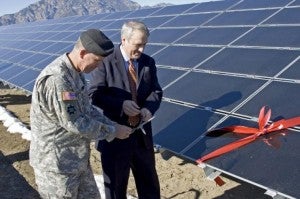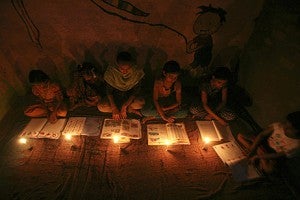
To download a copy of this briefing paper, please click here.
Hydraulic fracturing and horizontal drilling, processes used to extract natural gas from underground shale formations, have unlocked vast new domestic reserves — an unexpected abundance that has overturned many of America’s assumptions about energy. Every major-party candidate for public office in 2012, Republican or Democrat, must understand this new energy reality. And though each candidate’s position on natural gas development is likely to begin with a recognition of shale gas’s economic and energy security benefits, mastery of the issue requires a deeper level of understanding. Shale gas also brings with it a set of serious risks to public health and the environment — including impacts to water, air, land, local communities and the earth’s climate. At the local level in areas where shale gas production is intense, legitimate concerns over health and environmental impacts are shared by Republican, Democratic, and independent voters alike. No candidate’s position on natural gas can be considered complete unless it addresses these impacts.
In 2001, shale gas accounted for just 2% of America’s natural gas supply. Today, it accounts for more than 30% — while more than 90% of all new oil and gas wells being drilled in the U.S. make use of hydraulic fracturing. As unconventional natural gas production spreads into populous regions that are not accustomed to intensive industrial activity, its impacts have made it the object of intense local opposition, as manifested in the July 28th “Stop the Frack Attack” rally in Washington D.C and others like it in state capitals around the country. The environmental and public health concerns of local communities must be addressed if natural gas companies are to maintain their social license to operate.
Economic Benefits
While a majority of Americans remain unfamiliar with hydraulic fracturing, or “fracking,” according to a recent University of Texas poll, many will certainly applaud the economic benefits of low-cost natural gas. The natural gas revolution is driving:
- Job creation across the value chain, with rising demand for technical and professional services, for steel, pipelines and storage facilities, and for all the ancillary goods and services that arise in support of a rapidly growing industry.
- An unexpected expansion in the American chemical industry, with Dow and DuPont now building new plants close to shale formations. “If you had told me 10 years ago I’d be standing up on this podium making this announcement [about Dow’s $4 billion investment in four new Texas chemical plants], I would not have believed you,” Dow CEO Andrew Liveris said in April. “The cost of energy, the cost of feedstocks … was pricing the United States out of the market,” he said. But the shale “miracle” changed that.
- A revival in U.S steelmaking and other manufacturing industries. Nucor, which uses natural gas to make steel, is building a $750-million facility in Louisiana, just eight years after shutting down a similar plant in the same state.
- A new sense of the potential for U.S. energy independence and energy security.
Environmental Benefits
Increased development of shale gas could yield substantial environmental and public health benefits while helping the U.S. energy infrastructure become cleaner and less carbon-intensive. This highly desirable outcome will only be achieved, however, if the resource is developed responsibly. The potential exists because natural gas:
- Produces only about half the carbon dioxide of coal when burned.
- Produces about a third as much of the smog-forming nitrogen oxides that come from burning coal.
- Produces almost none of the mercury and sulfur dioxides that come from burning coal or oil.
For this reason, fueling power plants with natural gas instead of coal can dramatically cut conventional air pollution, can help reduce greenhouse gas emissions from the power sector and could help turn the tide against mountaintop removal mining and other environmentally disastrous industry practices. And because natural gas-fired power plants can cycle up quickly, they can be a nimble enabler of intermittent renewable energy sources in combination with demand response and emerging large-scale energy storage technologies.
Critically, if U.S. industry and regulators are successful in measuring and reducing methane pollution, which undermines natural gas’ role as a lower carbon alternative to coal and oil, the shale gas revolution can also bring a reduction in short-term radiative forcing — the driver of global climate change — over the next several decades. Leak reduction will determine how much of a role natural gas can play in a clean, low carbon future.
In short, natural gas could be a win-win benefiting both the economy and the environment — if we do it the right way. The right way means putting tough rules and mandatory environmental safeguards in place that protect communities and reduce methane pollution. There is no question that domestic unconventional gas supplies are leading to coal-fired power plants being retired. The public recognizes this benefit, but the jury is still out on whether shale resources can be produced responsibly. It’s no simple task to strike a balance between public safety and the development of this crucial energy resource, but it is essential that we do so. Americans deserve assurance that the economic, environmental and energy security benefits of shale gas development will be realized without sacrificing their health, safety, or the protection of the environment.
Clearly there are environmentally sensitive areas that should be off limits to natural gas development. And just as clearly there are some areas where intensive development will occur. Environmental Defense Fund is working with partners from academia, civil society, and industry to identify and minimize the impacts from the full range of gas development activities. Horizontal drilling and hydraulic fracturing attract significant press attention, but the issues of gas production are much broader than that.
Specific Areas of Concern
EDF sees five areas in which strong rulemaking is necessary:
- Mandating greater transparency in industry operations. Having good data is a prerequisite to understanding and mitigating risks, and it’s the first step toward winning back a badly damaged public trust. Regulators should require, and companies should embrace, disclosure policies that mandate reporting of not only the chemicals used in hydraulic fracturing, but also chemicals used in drilling and operating wells – as Ohio Governor John Kasich has advocated. Transparency should also be brought to other aspects of industry operations, such as detailed reporting of air emissions, chemical characterization of waste streams and tracking and reporting of water use and waste disposition. Company compliance histories should also be catalogued and reported, so companies with good records can get the credit they deserve and bad actors can be identified and pushed to improve performance.
- Modernizing rules for well construction and operation. Poor well construction and operation can lead to groundwater contamination and to blowouts that can endanger lives and foul the surface environment. In response, EDF is working with regulators and key stakeholders to strengthen rules for proper construction and operation of hydraulically fractured wells. While stronger regulatory oversight of well construction is needed, no one should try to suggest that hydraulic fracturing itself is risk free. Both aspects of well development need strong oversight.
- Strengthening regulations for waste and water management. Poor handling, storage and disposal of production fluids and other wastes is a major issue; chemical spillage is the leading cause of groundwater contamination from gas development activities. In response, EDF is pressing for measures to reduce spills, improve the use and handling of chemicals, and assure proper disposal (or recycling) of produced water. As mentioned above, a key missing ingredient here is better data on the chemical composition of waste streams. To be confident that handling, treatment and disposal practices are sufficient, authorities must know what substances are being handled. Finally, headline-grabbing reports of earthquakes connected to shale gas development have been linked to the waste disposal method known as deep well injection, not to hydraulic fracturing itself. This issue points to the need for improved seismic analysis prior to permitting of deep injection wells.
- Improving regulations to protect local and regional air quality. Air emissions resulting from the production, storage, processing, and transportation of natural gas can threaten public health. Leaks and routine venting during the extraction, processing and transportation of natural gas result in emissions of greenhouse gases and, depending on the local composition of unprocessed gas, other pollutants that contribute to locally- and regionally-elevated air pollution. In 2009, an SMU study estimated that the combined amounts of volatile organic compounds (VOC) and nitrogen oxide (NOx) emissions from oil and natural gas production in the Barnett Shale of North Texas were comparable to amounts of those emissions from the roughly 4 million cars and trucks in the adjoining Dallas Fort-Worth metro area. Fortunately, widely available and cost-effective remedies exist: repairing worn equipment, using “green” well completion techniques and eliminating venting are just a few. In the past five years, for example, Southwestern Energy says it has cut the cost of capturing stray emissions from $20,000 a well to close to zero. The company is capturing an average of 16 million cubic feet of gas that would otherwise have been released or flared. Southwestern also uses special pop-off valves to make sure natural gas is not released into the air from well casings. If pressure causes a valve to open, the gas is captured in a closed loop that returns it to the system, saving the resource. These systems cost just $600 to $1200 a piece.
- Developing innovative strategies to reduce community impacts. The cumulative impact of infrastructure development, traffic, noise, lights, and the like can overwhelm communities and intrude on sensitive ecosystems and habitats; none of this is easily addressed through conventional regulatory approaches. Instead, EDF recommends that states and local governments bring together stakeholders for scientifically based, bottom-up planning processes designed to address unique local needs. Likewise, the right of local communities to regulate the location of gas development through local zoning ordinances must be preserved. Gas operations shouldn’t receive special carve-outs from traditional local powers that other industrial activities must comply with.
President Obama has voiced his commitment to domestic energy production through safe and responsible natural gas development, declaring that “America will develop this resource without putting the health and safety of our citizens at risk.” EDF would like to see Governor Romney and other candidates across the land call for the same careful balance. Far from being an example of regulation that chokes economic growth, strong oversight of natural gas development is necessary to ensure the sector’s continued growth, by avoiding the public backlash that could slow or even derail natural gas development. Read More »
 Earlier this year, the California Public Utilities Commission (“CPUC”) issued a decision requiring the state’s investor-owned utilities to establish several financing programs, including an On-Bill Repayment (“OBR”) program for commercial properties. OBR programs allow property owners to finance energy efficiency and/or renewable energy projects with third-party banks or other investors. Property owners repay their loan via their utility bill and that obligation stays linked to the meter upon a sale of the property.
Earlier this year, the California Public Utilities Commission (“CPUC”) issued a decision requiring the state’s investor-owned utilities to establish several financing programs, including an On-Bill Repayment (“OBR”) program for commercial properties. OBR programs allow property owners to finance energy efficiency and/or renewable energy projects with third-party banks or other investors. Property owners repay their loan via their utility bill and that obligation stays linked to the meter upon a sale of the property.















